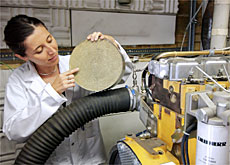Hydrogen powers futuristic car

Swiss researchers say hydrogen as a fuel is slowly coming of age, but warn that it is not yet ready to take to the road.
To prove their point, scientists at the Paul Scherrer Institute (PSI) have been helping develop a prototype car powered by hydrogen.
The Hy-Light concept car, developed in collaboration with tyre specialist Michelin, was presented recently in Shanghai.
According to Michelin, the Hy-Light was the most efficient fuel-cell vehicle taking part in the Bibendum Challenge in the Chinese city, beating competition from major car manufacturers in the economy stakes.
“It’s important for us to understand what mobility will be in ten to 15 years’ time since it will affect our core business,” said Pierre Varenne of Michelin. “So rather than sit and wait, we decided to develop our prototype.”
The tyre maker believes that hydrogen-based fuel-cell technology is the best possible replacement for fossil fuels.
Collaboration
To prove its point, the company’s research centre near Fribourg teamed up with the Paul Scherrer Institute, which has been working on fuel cells.
“We recognised it some time ago as one technology that could make mobility more sustainable,” said the institute’s Philip Dietrich.
Besides its fuel cell expertise, PSI also supplied special condensers. These electrical parts store electricity generated by the car’s braking, further lowering the Hy-Light’s hydrogen fuel consumption.
Hydrogen is considered by many specialists to be the fuel of the future. They say it is no more dangerous than petrol, and only produces water vapour as a by-product.
Hydrogen is a very volatile fuel, and to minimise the risk of explosion, it is stored in inter-connected pockets, which prevents large amounts of the gas being leaked in the event of a collision.
Dietrich says it will still be some years before hydrogen-powered vehicles hit the road.
“The automotive industry could adopt [hydrogen] fuel cells in ten or 15 years’ time, but it will depend on oil prices and political conditions,” he told swissinfo, adding that comfort and price would decide whether drivers chose hydrogen.
Drawbacks
To help car owners make up their minds about fuel-cell technology, demonstration vehicle fleets are already on the road in California, Tokyo and Berlin.
But there are still some hurdles to overcome, according to researchers. Hydrogen’s most obvious drawback is the volume required to store this gas.
“You have to find ways of transporting hydrogen in a vehicle,” said Alexander Wokaun of PSI. “However with more efficient cars, you can consider it as an alternative to gasoline since you need smaller tanks.”
Hydrogen is also expensive to produce, two to three times more than petrol. But Wokaun reckons that hurdle is not as big as some people might think.
“After tax, it’s a different picture, so there is room for the legislator to give fiscal incentives for hydrogen use,” he told swissinfo.
Emissions
Hydrogen itself may be non-polluting, but there is a sting in the tail. It is produced either as a by-product of the coal, oil or gas industries, or by splitting water molecules using copious amounts of electricity, often generated by nuclear power plants.
No current production technique is non-polluting.
“If you produce hydrogen from coal or oil, you still have some emissions,” admitted Dietrich. “That’s why we have to find sustainable ways of producing hydrogen.”
Researchers are pinning their hopes on solar-based production, a method Michelin is working on now.
Specialists say that eliminating pollution from the production process will also boost hydrogen’s chances of mainstream success.
“If you can introduce a method for producing hydrogen cheaply and cleanly, this would probably the best argument for its use,” Wokaun told swissinfo.
“Consumers will then realise the environmental benefits of hydrogen as a fuel.”
swissinfo, Scott Capper
A fuel cell is an electrochemical engine that converts the chemical energy of a fuel directly to electricity.
The fuel is almost always hydrogen or a hydrogen-rich gas mixture.
A fuel cell is similar to a battery in that both devices convert chemical energy directly to electricity.
Unlike a battery, a fuel cell never needs to be recharged.
Michelin and PSI teamed up to develop the HY-Light despite there being no car manufacturers in Switzerland.
Michelin says that it hopes to find industrial partners to commercialise the innovations developed for the prototype.
PSI, which sees technology transfer as a social responsibility, says that the Swiss economy, as a major supplier to the automotive industry, could benefit from the introduction of fuel-cell systems.

In compliance with the JTI standards
More: SWI swissinfo.ch certified by the Journalism Trust Initiative









You can find an overview of ongoing debates with our journalists here . Please join us!
If you want to start a conversation about a topic raised in this article or want to report factual errors, email us at english@swissinfo.ch.